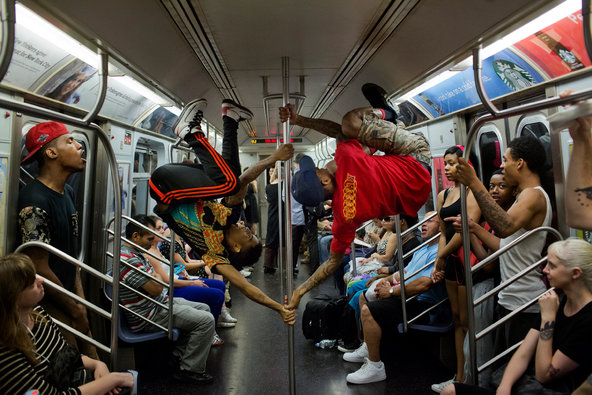
Should we move aside when these adventurous young people ask for space on an otherwise crowded subway car? I won’t say one way or the other. However, I want to comment on the moment of choice we are faced with, in-itself.
The act of subway acrobats asking for room to groove and our decision to give it (or not give it) are both expressions of public space, in my view. I think that’s the key to consider when these negotiations take place. Frankly, that is why I can’t help but admire and celebrate these urban activists. Yet, that’s not to say I always feel supportive of their activity.
When I first encountered a small group of teenagers wishing to combine break-dancing and pole-dancing on a moving subway car–all the way over the Manhattan Bridge–I thought they were merely vying to get some money. After the second time, and then the third, fourth, etc., I began to understand that they not only hoped to earn money, but an opportunity to get in our faces with their whirls and other moves. And get in our faces they did, with aplomb.
When I felt the wind made by a hightop sneaker across my nose, I turned angry inside. After a while, I learned to meet that anger with a somewhat affected stoicism. Later, I believe, I met that hightop-made wind with a new adrenaline and a certain wonder. That hightop woke me up in an erstwhile passive moment. It made me feel urgent, vital. It did much the same to my fellow subway riders, some of whom expressed impatient appeal, others, farther away from the action, exhibited support.
There is certainly more to say on the matter, which I hope to do in this blog. To be sure, I want to develop this theme further. I want to talk about it, since I certainly can’t do those intrepid moves. For now, the point I wish to emphasize is that these young acrobats are social agents in their own way. They are capable of unnerving us; they may even offend us with their demands to share our subway cars, especially, we sometimes grumble, when they don’t have to ride them to work like we do.
But they are our speakers, our activists–our waker-uppers–the moment they board the car and hit the “play” button. In turn, we are their listeners, sources of validation for the politics they wish to practice. To me, those politics are the politics of too few (good) job opportunities for young people in the city. They are simultaneously the politics of visibility for the under-served, the politics of toleration, of diversity and unexpectedness, of something controversial, insurgent, and yet more open when the music finishes.
For it is in that moment, the interstice between the last beat played and the hat cum acrobat’s prop passed around the subway car, that the city and its ongoing contests for civil rights are reanimated.
I, for one, look forward to that latter moment, at least. And I am thankful for it each time I play the role of its witness.